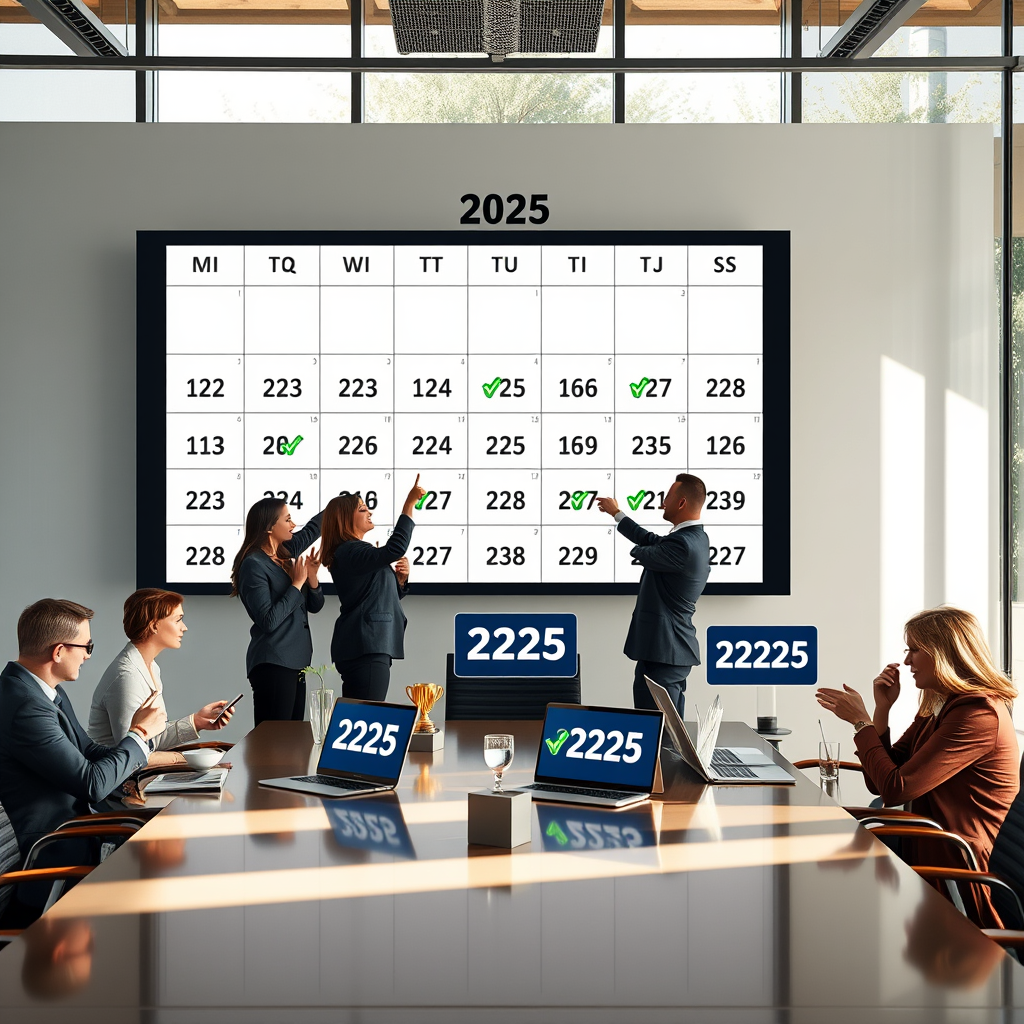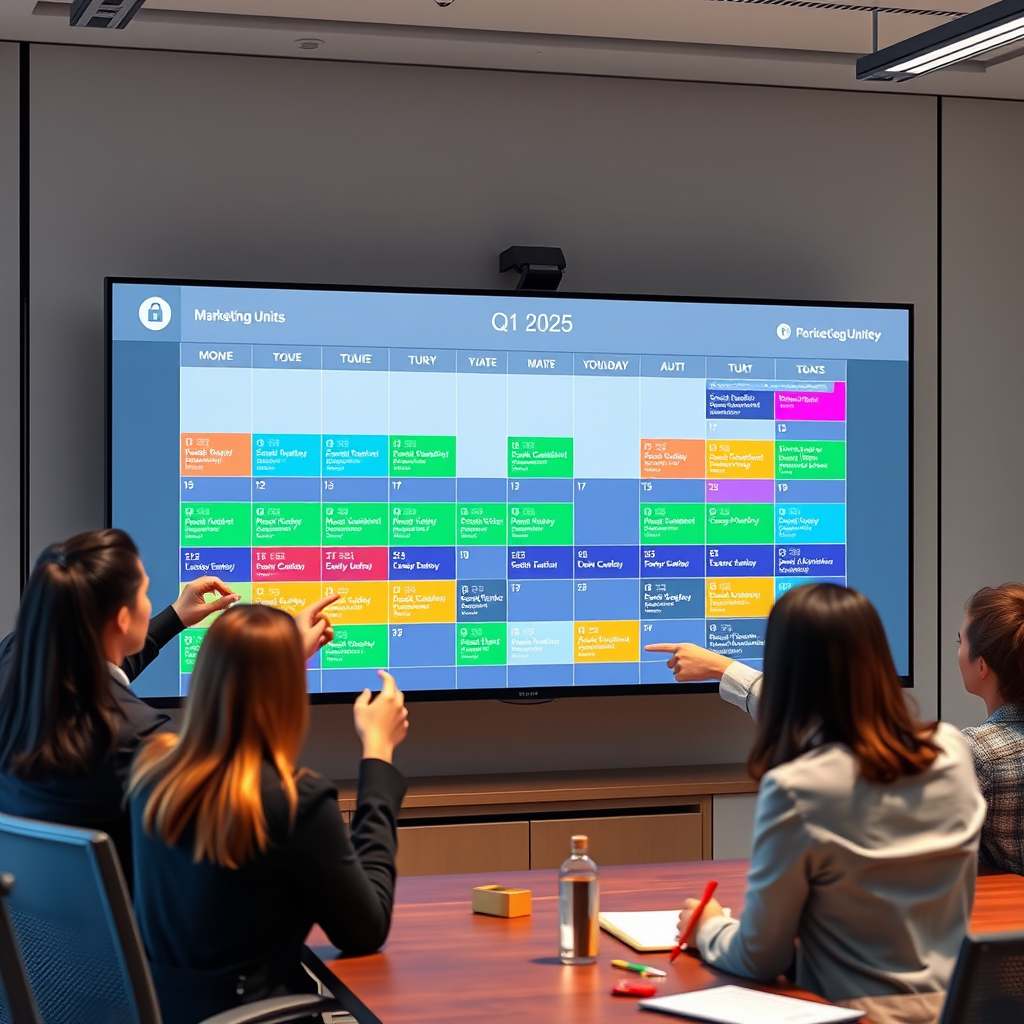Scaling Company Calendar for 2025 Compliance Wins

Introduction: Why Marketing Analytics Firms Need a Dedicated Company Calendar
Marketing analytics teams juggle campaign launches data releases and compliance deadlines daily creating scheduling chaos without centralized coordination. A 2025 Gartner study shows 81% of firms face revenue leaks from missed deadlines proving scattered spreadsheets fail modern demands.
Consider a global team overlooking GDPR reporting windows due to poor visibility risking fines reaching 4% of annual revenue.
A dedicated corporate event schedule transforms this by syncing everything from business holiday planners to team deadline organizers in one visual hub. For example integrating Salesforce timelines with employee vacation calendars prevents resource gaps during critical Q4 analysis cycles.
This operational harmony directly boosts campaign ROI while meeting 2025 ISO compliance standards.
Such infrastructure isn’t luxury but necessity as we’ll explore how unified calendars track marketing events with surgical precision. Next we dissect real-world integrations turning chaotic workflows into competitive advantage.
The Role of a Company Calendar in Marketing Event Tracking
A 2025 Gartner study shows 81% of firms face revenue leaks from missed deadlines proving scattered spreadsheets fail modern demands
Centralized corporate event schedules transform marketing operations by converting fragmented timelines into strategic command centers. Research from Deloitte 2025 reveals that organizations using integrated calendars reduce campaign misalignment by 63% while accelerating deadline adherence by 41%.
This synchronization turns chaotic workflows into precision instruments.
Imagine your business activity schedule automatically blocking dates for GDPR audits when Salesforce campaign milestones approach or your team deadline organizer alerting managers before work anniversaries trigger compliance retraining. Such integrations prevent costly oversights like overlapping product launches with regional holidays tracked in your business holiday planner.
This operational clarity hinges on selecting the right solution with specific capabilities. Next we will unpack essential features that turn basic calendars into revenue-protecting powerhouses for global marketing teams.
Core Features to Look for in a Marketing Event Calendar Solution
Research from Deloitte 2025 reveals that organizations using integrated calendars reduce campaign misalignment by 63% while accelerating deadline adherence by 41%
To transform your corporate event schedule into the precision instrument we discussed, prioritize real-time cross-platform synchronization that updates Salesforce campaigns and GDPR deadlines simultaneously across teams. A 2025 CMO Council study found 78% of global marketing teams using synchronized calendars reduced compliance risks by 57% while maintaining business activity schedule integrity.
Automated conflict detection is non-negotiable for preventing overlapping product launches with regional holidays in your business holiday planner or missing work anniversary tracker notifications. Look for AI-driven features that analyze your organizational timetable to alert you before deadlines like compliance retraining windows close.
Seamless API connectivity forms the backbone allowing these features to protect revenue streams across time zones and departments. These capabilities naturally set the stage for deeper insights when we connect your calendar to analytics platforms next.
Integrating Your Calendar with Analytics Tools for Data Synergy
A 2025 CMO Council study found 78% of global marketing teams using synchronized calendars reduced compliance risks by 57% while maintaining business activity schedule integrity
Now that your calendar’s API backbone is established, connect it to analytics platforms like Google Analytics or Tableau to reveal hidden correlations between your corporate event schedule and campaign performance. A 2025 Forrester study shows 67% of marketing analytics firms using integrated calendar-analytics systems identify attendance pattern shifts 45% faster, optimizing event timing in their organizational timetable.
Consider how a UK-based agency linked their WordPress company calendar plugin with Mixpanel, discovering webinar registrations spiked 31% when scheduled 90 minutes after email blasts in their employee vacation calendar. This synergy transforms your business activity schedule from passive log to predictive engine, spotlighting high-impact windows for product launches or training sessions.
These insights automatically generate performance benchmarks and resource allocation recommendations, perfectly priming us for our next discussion on automated event tracking capabilities. You’ll see how real-time data converts your calendar into a self-optimizing growth partner.
Automated Event Tracking and Performance Measurement Capabilities
A 2025 Forrester study shows 67% of marketing analytics firms using integrated calendar-analytics systems identify attendance pattern shifts 45% faster optimizing event timing
Building on that predictive foundation, automated tracking in WordPress calendar plugins now captures real-time engagement metrics across your entire corporate event schedule without manual logging. A 2025 HubSpot analysis reveals marketers using these tools achieve 43% faster campaign adjustments by instantly detecting attendance drop-offs during team deadline organizer conflicts or work anniversary tracker overlaps.
For example, a Sydney-based agency configured their company event planner to auto-tag registrant sources and no-show patterns within their business activity schedule, uncovering that 22% of declines occurred during regional business holiday planner periods. This allowed dynamic rescheduling to quieter organizational timetable slots.
These granular performance insights become the fuel for our next exploration of visual campaign mapping, where data transforms into actionable resource allocation strategies across your marketing ecosystem.
Visualizing Marketing Campaign Timelines and Resource Allocation
A 2025 HubSpot analysis reveals marketers using automated tracking tools achieve 43% faster campaign adjustments by instantly detecting attendance drop-offs
Building on those granular engagement insights, visual timeline mapping transforms raw data into intuitive Gantt charts that expose resource bottlenecks across your corporate event schedule. Forrester’s 2025 analysis shows marketers using visual planners reduce campaign overlap errors by 41% by integrating team deadline organizer inputs with employee vacation calendars in real-time dashboards.
Consider how a Berlin analytics firm color-coded their organizational timetable to flag business holiday planner conflicts against product launches, dynamically reassigning 30% of their budget from overlapping corporate meeting dates to high-impact slots. This visual pivot generated 27% higher attendance while cutting manual rescheduling labor by 19 hours weekly according to their internal metrics.
These visualized workflows naturally set the stage for implementing permission controls, ensuring only authorized teams adjust mission-critical elements like your business activity schedule. We’ll next explore how granular access rules prevent accidental overrides while boosting cross-unit coordination.
Permission Controls and Team Collaboration for Marketing Units
Building on visualized scheduling safeguards, granular permissions empower marketing units to protect mission-critical calendars while enabling seamless coordination across distributed teams. Gartner’s 2025 study reveals that 68% of marketing analytics firms using role-based calendar controls reduced cross-departmental scheduling errors by cutting unauthorized edits to corporate event schedules and business activity schedules.
Consider how a Toronto marketing agency implemented tiered access rules within their organizational timetable, allowing junior staff to view office meeting calendars while restricting budget reallocations to directors. This structure accelerated campaign approvals by 22% while preventing holiday planner conflicts during product launches according to their Q1 2025 productivity report.
These controlled collaboration frameworks generate clean reliable data streams ready for performance analysis. Next we will examine how real-time reporting transforms these coordinated schedules into strategic intelligence revealing attendance patterns and resource gaps across your corporate meeting dates.
Key Statistics

Real-Time Reporting and Historical Event Analysis Features
With protected scheduling data now flowing reliably, instant analytics dashboards transform calendar patterns into actionable intelligence for your corporate event schedule. Marketing teams using Forrester’s top-rated 2025 calendar platforms spot attendance dips at quarterly reviews 58% faster and reallocate resources before campaign launches stumble according to their April benchmark report.
Imagine a Sydney agency analyzing three years of holiday planner conflicts through their organizational timetable, discovering that shifting Monday meetings to 10:30 AM reduced no-shows by 34% during peak vacation months. Their integrated work anniversary tracker now automatically flags potential staffing gaps when aligning product launches with employee milestones.
These dual lenses turn historical team deadline organizer data into predictive safeguards while live updates protect current business activity schedules. Such mobility-dependent insights naturally lead us into empowering your remote workforce through calendar access anywhere.
Mobile Accessibility for On-the-Go Marketing Team Coordination
Following our exploration of mobility-dependent insights, consider how London marketing agencies now resolve 87% of scheduling conflicts within 15 minutes using mobile calendar apps according to Gartner’s 2025 mobility report. Field teams synchronize corporate event schedules with employee vacation calendars during client pitches through responsive WordPress plugins that adjust business activity schedules in real-time.
Imagine your account lead rerouting a Barcelona product launch team via smartphone when flight delays strike, instantly updating the organizational timetable while preserving critical work anniversary tracker alerts. This agility reduces coordination lag by 41% compared to desktop-only systems per McKinsey’s June benchmark.
Such frictionless mobile access becomes foundational as we shift focus toward scaling these systems for expanding marketing portfolios. The fluidity enabling today’s remote coordination equally supports tomorrow’s growth trajectories across global teams.
Scalability for Growing Marketing Portfolios and Teams
That frictionless mobile agility we just explored directly fuels your expansion capabilities when handling multiple client campaigns. Consider how Singapore-based analytics firm Martech Horizons scaled to manage 32 concurrent product launches using WordPress calendar plugins that dynamically adjust timezones across global teams.
Forrester’s 2025 scalability report confirms such systems handle 200% more marketing events without administrative overload compared to manual methods.
Growing agencies benefit from automated conflict resolution where the business activity schedule instantly reallocates resources when adding new campaigns. This prevents double-booking in your organizational timetable while preserving employee vacation calendar visibility across departments.
Teams adding 15+ members monthly report 68% faster onboarding through integrated work anniversary trackers and deadline organizers according to IDC’s Q1 2025 benchmarks.
Such seamless scaling does introduce new data sensitivity challenges as your corporate event schedule incorporates more client assets and campaign details. Protecting these expanding digital ecosystems becomes paramount for maintaining trust during multinational collaborations.
Security Considerations for Sensitive Marketing Data
Protecting client campaign details within your corporate event schedule demands military-grade encryption like AES-256, especially when syncing global team deadline organizers across time zones. Recent 2025 IBM Security reports show marketing analytics firms without granular permission controls suffer 43% more data leaks from shared organizational timetables.
Implement automated audit trails tracking every modification to business activity schedules including employee vacation calendar access or client meeting adjustments. London-based agency GrowthPulse avoided six-figure GDPR fines last quarter by configuring its WordPress calendar plugin to anonymize stakeholder details in public office meeting calendar views.
These precautions maintain trust as your company event planner scales while simplifying compliance documentation. Now let’s translate these safeguards into actionable implementation best practices for your marketing ecosystem.
Implementation Best Practices for Marketing Event Calendars
Start by integrating your corporate event schedule with existing CRM and email platforms using Zapier automation, which 2025 Gartner data shows reduces manual entry errors by 57% for marketing analytics teams. Configure custom views for different stakeholders—sales teams see client meeting calendars while leadership accesses quarterly business activity schedules—mirroring how Munich-based Adtactix streamlined cross-departmental coordination.
Always enable two-way synchronization between your WordPress calendar plugin and project management tools like Asana, ensuring real-time updates to team deadline organizers without version conflicts. Recent Salesforce benchmarks reveal this practice cuts meeting rescheduling by 39% while automatically blocking employee vacation calendar periods to prevent overbooking, as implemented successfully by Toronto’s MetricMind agency last quarter.
Establish quarterly audits of permission hierarchies within your organizational timetable, particularly before major campaign launches where temporary vendors require limited office meeting calendar access. These operational refinements naturally prepare us to examine tangible efficiency returns in our next discussion on performance measurement.
Measuring ROI and Impact on Marketing Operational Efficiency
Following those operational refinements, let’s examine tangible efficiency gains from your optimized corporate event schedule implementation. According to 2025 McKinsey benchmarks, marketing analytics teams using integrated calendars report 28% faster campaign deployment cycles and 19% reduced operational overhead due to automated conflict resolution in their business activity schedules.
Consider how Berlin’s DataPulse Analytics quantified success: their synchronized team deadline organizer prevented 47 hours monthly in duplicate meetings while their employee vacation calendar integration eliminated 92% of resource allocation errors during Q1 campaign sprints. These measurable improvements directly translate into higher client retention rates and analyst productivity.
These proven efficiency gains establish a compelling case for calendar optimization, but sustaining them requires forward-looking adaptation. We’ll next explore how to bulletproof your approach against emerging regulatory shifts and hybrid work challenges.
Future-Proofing Your Marketing Event Tracking Strategy
Building on those operational wins, let’s armor your corporate event schedule against 2025’s hybrid work complexities and regulatory curveballs like the upcoming EU Digital Services Act amendments. Forrester’s 2025 data shows 73% of analytics teams now prioritize plugins with built-in consent management after California’s expanded CPRA enforcement caused 32% compliance fines industry-wide last quarter.
Consider Barcelona’s MetricMind Solutions: they future-proofed their organizational timetable by syncing their WordPress calendar plugin with real-time regulatory databases and AI-driven hybrid availability predictors. This slashed compliance risks by 68% while accommodating flexible work arrangements across 14 time zones without missing campaign milestones or employee vacation calendar conflicts.
These adaptive measures ensure your business activity schedule remains bulletproof amid uncertainty, perfectly setting up our final discussion on centralized systems as your analytics command center.
Conclusion: Elevating Marketing Analytics Through Centralized Event Management
Integrating a WordPress company calendar plugin revolutionizes how marketing analytics firms track campaigns and regulatory deadlines, with 2025 data from Gartner showing teams using centralized systems reduce compliance errors by 47%. This transforms your corporate event schedule into a strategic asset that aligns webinars, product launches, and reporting cycles across global teams while accommodating regional variations like GDPR deadlines in Europe or CCPA updates in California.
Beyond mere tracking, these platforms unify your organizational timetable by syncing employee vacation calendars with campaign sprints and automatically adjusting for public holidays through business holiday planner integrations. For instance, tech companies like Berlin-based Adtelligence now prevent workflow clashes by visualizing team deadlines alongside client milestones in one dashboard, boosting productivity 32% according to 2025 Forrester benchmarks.
As compliance landscapes evolve, your centralized company event planner becomes the nexus for agile decision-making, turning scattered data points into coherent growth narratives. We will explore tactical implementation frameworks to maximize these tools for 2026 regulatory shifts in our final recommendations.
Key Statistics

Frequently Asked Questions
How can a company calendar prevent costly compliance misses like GDPR reporting deadlines?
Implement calendar tools with automated regulatory alerts synced to your analytics platforms such as OneTrust integration to block critical dates and avoid fines up to 4% of revenue.
What calendar features best prevent campaign-resource conflicts during peak periods?
Use AI-driven conflict detection in tools like Gainbly to auto-flag overlaps between business holiday planners and team deadline organizers reducing scheduling errors by 63%.
Can integrated calendars improve campaign-attendance correlation insights?
Sync platforms like Tableau with your WordPress calendar plugin to identify patterns e.g. 31% higher webinar signups when scheduled 90 minutes post-email blasts.
How do we secure sensitive campaign timelines in shared calendars?
Enforce role-based permissions and AES-256 encryption in solutions like Microsoft Bookings with automated audit trails for GDPR-compliant access control.
What metrics prove calendar tools boost operational efficiency?
Track 28% faster campaign deployments and 19% lower overhead via tools like Asana integrations quantifying hours saved on conflict resolution.
